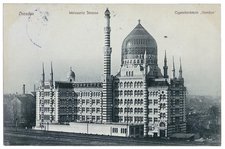The Dark Underbelly of the Belle Époque

It's not just beauty that's in the eye of the beholder; whatever we perceive inevitably refers back to us, the perceivers. The cover of Wolf-Dieter Lemke's illustrated book "Staging the Orient" features a three-dimensional, stereoscopic image that symbolizes perfectly the discrepancy between image and reality.
Lemke analyses European representations of the Orient in the late 19th and early 20th centuries and examines the inherent tension between truth, cliché and fantasy.
The Orient, admired and demonised
Our perspective on the Orient has always been limited by our tunnel vision, and the term "Orientalism" denotes a kind of blind European smugness. The West has long since been tried, found guilty, and sentenced to a period of intensified reflection on itself and its dealings with the rest of the world; so it's now generally accepted that "the West" invented itself in contradistinction to a largely-imaginary "Other" – an "Orient" of its own invention, simultaneously admired and demonised.
This invented identity was based on a fragile dialectical relationship. Subjected to various historical upheavals, it frequently altered its themes and paradigms, so that it would be difficult to trace a continuous line of development that goes beyond the mechanism of "othering" itself.
Lemke has presented his material carefully and thoughtfully; and by focusing on a relatively small but still current aspect of this endlessly complex subject matter, he has brought the airy post-colonial theorising of recent years down to earth. What interests him is the popularisation of "the Orient" in the Europe of the fin de siècle.
The Orient flowing into art, architecture, and design
At that time, pictures were flooding the continent, the revolutionary invention of photography was flourishing, and the emerging consumer society was beginning to create and exploit something entirely new: mass taste.
How was the Orient imagined and presented during this period? How did the imagery proliferate, from academic art to the expensive kitsch that adorned middle-class drawing-rooms to the iconography of advertising? How did the Orient affect architecture, fashion and literature? Lemke's astonishing book answers these questions with a multitude of illustrations. The Head Librarian of the German Institute for Oriental Studies in Beirut and Istanbul has produced what can only be called an eye-opener.

The Orient of the belle époque is sensual: glittering, sweet-smelling, enchanting. It promises luxury, beauty and splendour. It is noble, yet hedonistic to the point of overkill, and deliriously seductive; it is a Utopian fulfilment of desires that can barely be entertained in quotidian reality.
An inventory of Western "Orientalist" painting would include clammily erotic harem fantasies, opulent scenarios of exorbitant sensuality, picturesque slave markets and bloody palace revolts.
Taste for the exotic as a mass phenomenon
But as the age of the image came to maturity, it was photography that made the monstrous promise to show things as they truly were. From the late 19th century onwards, new technology, media and modes of production ensured that images could proliferate as never before. Postcards become extremely popular, and Lemke's exceptionally extensive private collection forms the basis for his book.
A taste for the exotic had previously been the privilege of a small elite; now, it became a mass phenomenon. Sights seen only by a handful of wealthy eccentrics were suddenly available to the masses, at carnivals, in zoos, and (not least) at World Fairs – huge, extravagant spectacles that attracted millions.
In keeping with its subject, the book is gorgeous to look at. The text (in English and French) is clearly and straightforwardly written, and the layout ensures that the words frame the images without overwhelming them.
Lemke is neither a grimly finger-wagging critic of Eurocentrism nor a frivolously enthusiastic aesthete.
It's clear that he loves his chosen topic, yet he's fully aware of the dark underbelly of the epoch, which included a widespread, cynical and dehumanising racism.
Andreas Pflitsch
© Qantara.de 2006
Translated from the German by Patrick Lanagan
Wolf-Dieter Lemke: Staging the Orient. Fin de Siècle Popular Visions / Représentations de l'Orient. Imagerie Populaire Fin de Siècle. Beirut: Editions Dar An-Nahar, 2004, 238 pp.
Qantara.de
Rifa'a Rafi' al-Tahtawi
France as a Role Model
In the 19th century it was not only Europeans who were seized by the wanderlust to see the Orient. The number of people traveling in the opposite direction, from the Orient to Europe, also rose rapidly. Barbara Winckler reports
The Orient Catches on in Great Britain
Warm and Fuzzy about the Orient
The western world has experienced a surge of interest in Arab pop music and lifestyle. Take London, for example: in trendy cafés young Brits lounge on soft cushions, smoking hookahs to Arabicized sounds and beats. Thomas Burkhalter takes a look
Hans Werner Geerdts
A Rare Symbiosis
The German painter and writer Hans Werner Geerdts has been living in the Moroccan city of Marrakesh for more than sixty years. His art has made its presence felt throughout the country. Christoph Leisten presents this portrait of the artist on the occasion of his eightieth birthday